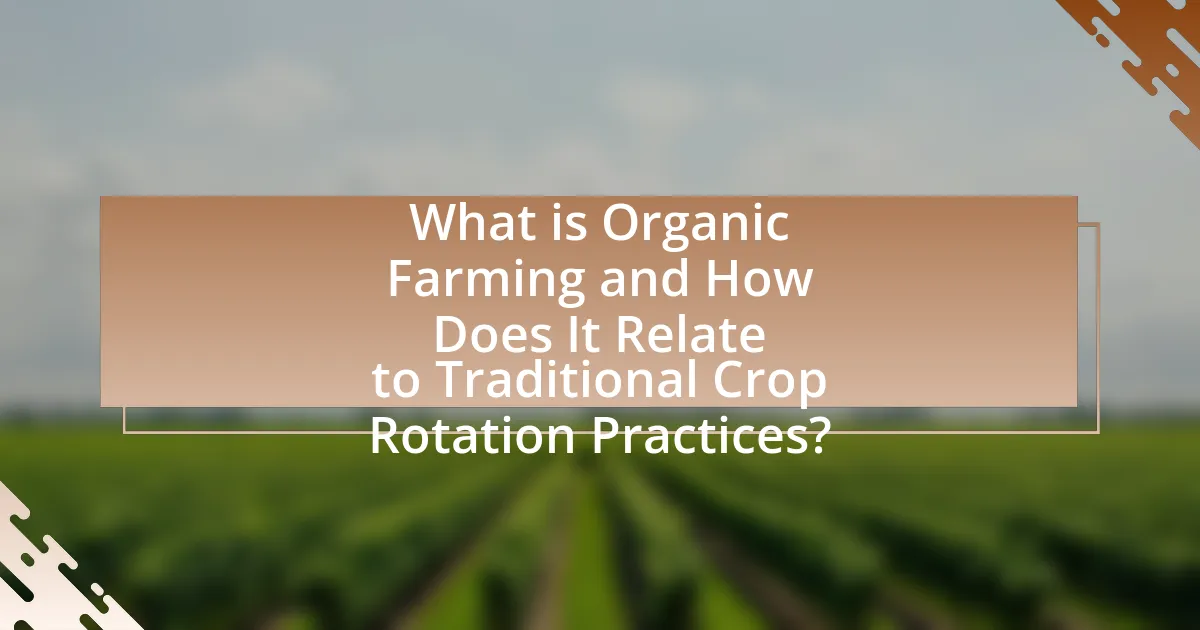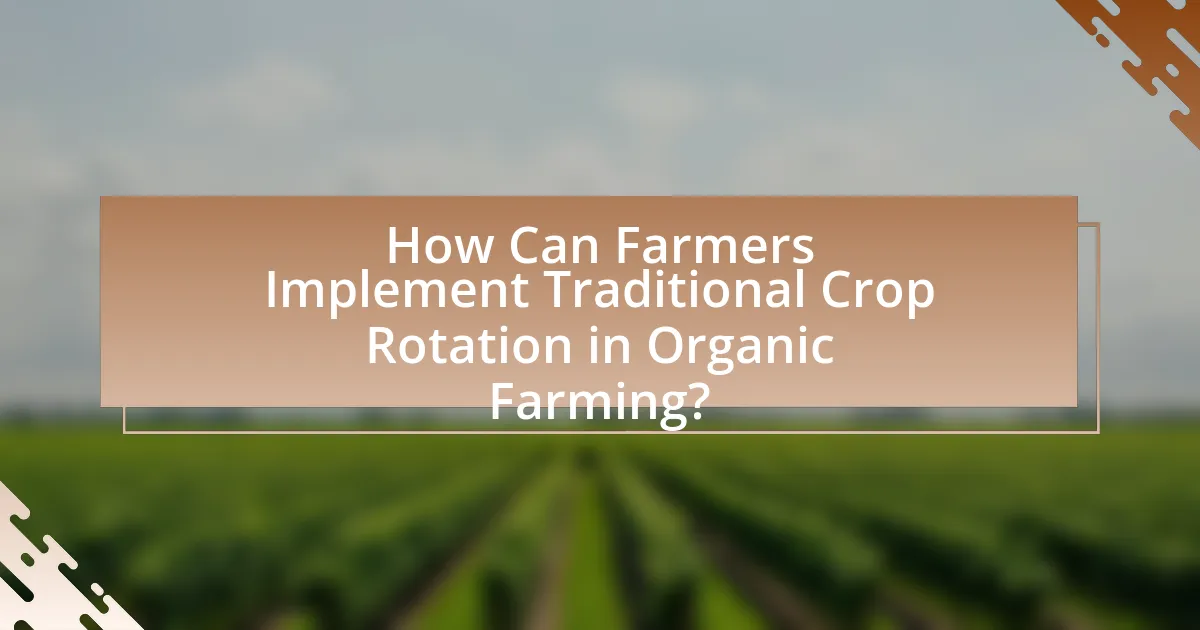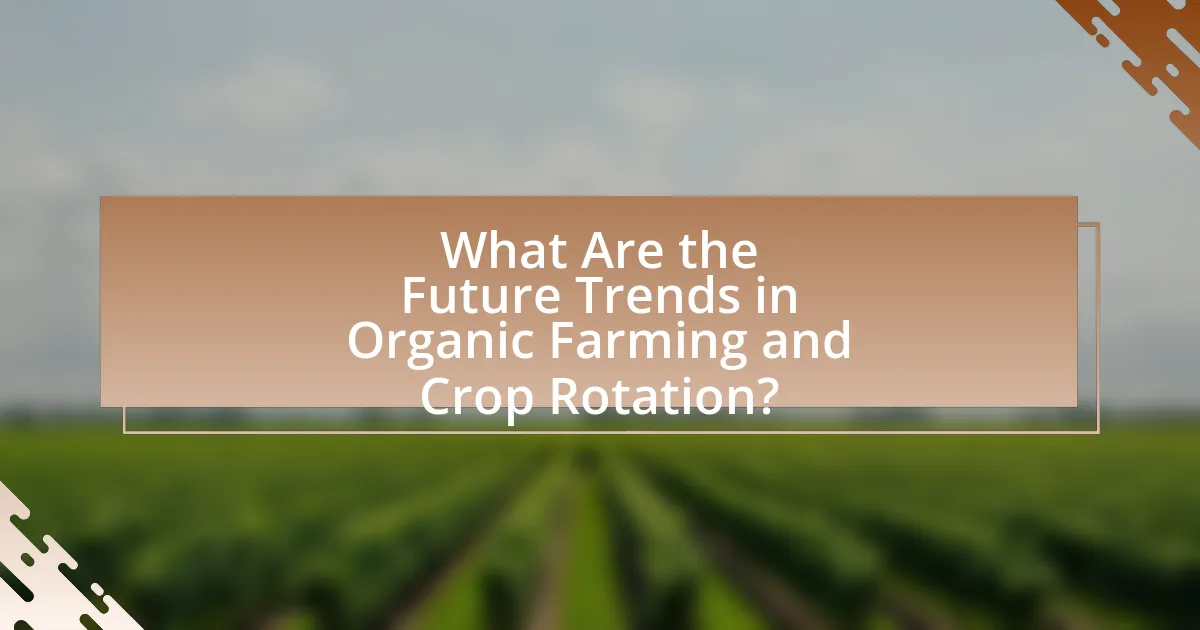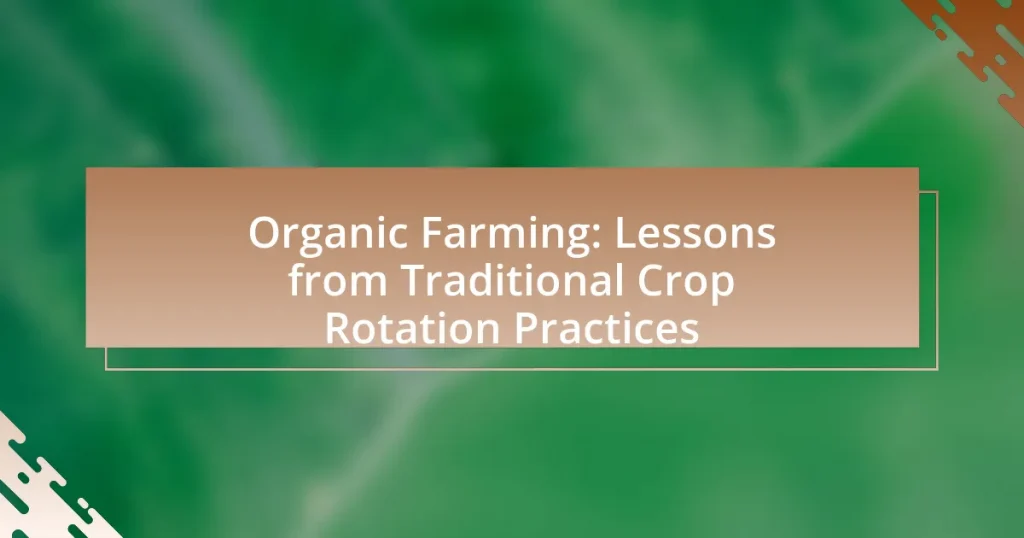Organic farming is an agricultural method that prioritizes natural processes and materials, avoiding synthetic fertilizers and pesticides, and is closely related to traditional crop rotation practices. This article explores the significance of organic farming in modern agriculture, emphasizing its benefits for soil health, biodiversity, and ecosystem balance. It details the core principles of organic farming, the role of crop rotation in enhancing soil fertility and pest control, and the ecological advantages of diverse cropping systems. Additionally, the article examines how traditional crop rotation methods have influenced contemporary organic practices and outlines best practices for farmers to implement effective crop rotation strategies.

What is Organic Farming and How Does It Relate to Traditional Crop Rotation Practices?
Organic farming is an agricultural method that emphasizes the use of natural processes and materials, avoiding synthetic fertilizers and pesticides. This practice relates to traditional crop rotation as both aim to enhance soil health and biodiversity. Traditional crop rotation involves alternating the types of crops grown in a specific area to prevent soil depletion and control pests naturally. Research indicates that organic farming often incorporates crop rotation as a fundamental practice, improving soil fertility and reducing the need for chemical inputs, thereby aligning with the principles of sustainability and ecological balance inherent in both approaches.
Why is Organic Farming Important in Today’s Agriculture?
Organic farming is important in today’s agriculture because it promotes sustainable practices that enhance soil health, biodiversity, and ecosystem balance. This method reduces reliance on synthetic fertilizers and pesticides, which can harm the environment and human health. According to the Food and Agriculture Organization (FAO), organic farming can increase soil organic matter, improve water retention, and reduce erosion, leading to more resilient agricultural systems. Additionally, organic farming practices contribute to the conservation of biodiversity, as they often involve crop rotation and polyculture, which support a wider variety of species. Studies have shown that organic farms can yield comparable or even higher outputs than conventional farms while maintaining ecological integrity, making organic farming a vital component of modern agriculture.
What are the core principles of Organic Farming?
The core principles of organic farming include the use of natural inputs, biodiversity, soil health, and ecological balance. Organic farming emphasizes the avoidance of synthetic fertilizers and pesticides, promoting instead the use of organic matter and natural pest control methods. This approach enhances soil fertility and structure, which is crucial for sustainable crop production. Additionally, organic farming practices encourage crop rotation and polyculture, which contribute to biodiversity and reduce pest and disease pressures. Research indicates that organic farming can improve soil health and increase resilience against climate change, as demonstrated in studies by the Rodale Institute, which found that organic systems can sequester more carbon in the soil compared to conventional methods.
How does Organic Farming differ from conventional farming methods?
Organic farming differs from conventional farming methods primarily in its approach to soil health, pest management, and the use of synthetic inputs. Organic farming emphasizes the use of natural fertilizers, such as compost and manure, to enhance soil fertility, while conventional farming often relies on synthetic fertilizers that can degrade soil quality over time. Additionally, organic farming employs integrated pest management techniques that prioritize natural predators and biological controls, whereas conventional methods frequently utilize chemical pesticides that can harm beneficial organisms and lead to pesticide resistance. According to the USDA, organic farming practices can improve biodiversity and soil health, which are critical for sustainable agriculture.
What Role Does Crop Rotation Play in Organic Farming?
Crop rotation plays a crucial role in organic farming by enhancing soil fertility, controlling pests, and reducing disease incidence. This agricultural practice involves alternating the types of crops grown in a specific area across seasons, which helps to maintain nutrient balance in the soil. For instance, legumes, when planted, fix nitrogen in the soil, benefiting subsequent crops that require nitrogen. Research indicates that crop rotation can lead to a 10-20% increase in crop yields compared to monoculture systems, as it disrupts pest and disease cycles, thereby minimizing the need for chemical interventions. Additionally, diverse cropping systems improve soil structure and biodiversity, which are essential for sustainable organic farming practices.
How does crop rotation enhance soil health?
Crop rotation enhances soil health by improving nutrient availability and reducing soil erosion. Different crops have varying nutrient requirements and root structures, which helps maintain a balanced nutrient profile in the soil. For instance, legumes, such as beans and peas, fix nitrogen in the soil, enriching it for subsequent crops. Additionally, rotating crops minimizes the risk of pest and disease buildup, as many pests are crop-specific. Research indicates that fields with diverse crop rotations can yield up to 20% more than monoculture systems, demonstrating the effectiveness of this practice in promoting soil vitality and sustainability.
What are the ecological benefits of crop rotation in organic systems?
Crop rotation in organic systems enhances soil health, increases biodiversity, and reduces pest and disease pressure. By alternating different crops, organic farmers improve soil structure and fertility through varied root systems and nutrient uptake, which can lead to increased organic matter and microbial activity. Research indicates that crop rotation can reduce the incidence of soil-borne diseases and pests, as different crops disrupt their life cycles. For example, a study published in the journal “Agriculture, Ecosystems & Environment” by Drinkwater et al. (1998) found that diverse crop rotations significantly decreased pest populations and improved overall crop yields.
What Lessons Can Be Learned from Traditional Crop Rotation Practices?
Traditional crop rotation practices teach the importance of biodiversity and soil health in sustainable agriculture. By alternating different crops in a specific sequence, farmers can enhance soil fertility, reduce pest and disease cycles, and improve crop yields. For example, rotating legumes with cereals can fix nitrogen in the soil, benefiting subsequent crops. Historical data shows that traditional practices have led to increased resilience against climate variability and reduced reliance on chemical fertilizers, as evidenced by studies indicating that crop rotation can improve soil organic matter by up to 30%.
How have traditional practices influenced modern organic farming techniques?
Traditional practices have significantly influenced modern organic farming techniques by emphasizing sustainable crop rotation and biodiversity. These practices, rooted in ancient agricultural methods, promote soil health and pest management, which are foundational principles of organic farming. For instance, traditional crop rotation methods, such as alternating legumes with cereals, enhance soil fertility through nitrogen fixation and reduce pest populations by disrupting their life cycles. Research indicates that farms employing these traditional techniques can achieve higher yields and improved soil quality, demonstrating their effectiveness in contemporary organic farming systems.
What specific traditional crop rotation methods are most effective?
The most effective traditional crop rotation methods include the three-field system, the four-field system, and intercropping. The three-field system, practiced in medieval Europe, involved rotating crops among three fields: one for winter grains, one for spring grains, and one left fallow, which improved soil fertility and reduced pest cycles. The four-field system, developed later, rotated four different crops, such as wheat, barley, turnips, and clover, enhancing soil nutrients and crop yields. Intercropping, where two or more crops are grown simultaneously in the same field, maximizes land use and minimizes pest infestations. Historical evidence shows that these methods significantly increased agricultural productivity and sustainability, as documented in studies by agricultural historians and agronomists.

How Can Farmers Implement Traditional Crop Rotation in Organic Farming?
Farmers can implement traditional crop rotation in organic farming by systematically alternating different crops in a specific sequence over time to enhance soil fertility and reduce pest and disease pressure. This practice involves selecting crops that have varying nutrient requirements and growth habits, such as legumes to fix nitrogen, followed by deep-rooted plants to improve soil structure. Research indicates that crop rotation can lead to a 10-20% increase in yield and a significant reduction in the need for synthetic fertilizers and pesticides, as diverse cropping systems promote beneficial soil microorganisms and disrupt pest life cycles.
What are the steps to develop a crop rotation plan?
To develop a crop rotation plan, follow these steps: first, assess the soil type and nutrient needs of your crops. Understanding the soil’s characteristics helps in selecting compatible crops that enhance soil health. Next, identify the crops you want to grow, considering their growth cycles and nutrient requirements. This selection should include legumes, which fix nitrogen, and other crops that can benefit from this process.
Then, create a rotation schedule that outlines which crops will be planted in each field over several seasons, typically spanning three to five years. This schedule should alternate deep-rooted and shallow-rooted plants to optimize nutrient uptake and minimize soil compaction.
Finally, monitor the results of your crop rotation plan by observing soil health, pest populations, and crop yields. Adjust the plan as necessary based on these observations to improve effectiveness. Research indicates that effective crop rotation can increase yields by 10-25% and reduce pest and disease incidence, supporting the benefits of this practice in organic farming.
How do you select crops for rotation based on soil and climate?
To select crops for rotation based on soil and climate, farmers assess soil type, nutrient levels, and climate conditions to determine suitable crops. For instance, sandy soils drain quickly and may favor drought-resistant crops like millet, while clay soils retain moisture and can support water-intensive crops like rice. Additionally, climate factors such as temperature and rainfall patterns influence crop viability; for example, legumes can enhance soil nitrogen levels in cooler climates, benefiting subsequent crops. Research indicates that crop rotation improves soil health and reduces pest populations, supporting sustainable farming practices.
What timing considerations are important for effective crop rotation?
Effective crop rotation requires careful timing to optimize soil health and crop yields. Key timing considerations include planting and harvesting schedules that align with the growth cycles of different crops, ensuring that crops are rotated before pests and diseases can establish. Additionally, the timing of cover crop planting and termination is crucial, as it enhances soil fertility and structure while preventing erosion. Research indicates that rotating crops every season can reduce the buildup of pathogens and pests, thereby improving overall crop resilience and productivity.
What Challenges Might Farmers Face When Adopting Traditional Crop Rotation?
Farmers may face several challenges when adopting traditional crop rotation, including knowledge gaps, initial costs, and market demand fluctuations. Knowledge gaps arise as farmers may lack experience or training in effective rotation practices, which can lead to suboptimal crop yields. Initial costs can be significant, as transitioning to a new system often requires investment in new seeds, equipment, or soil amendments. Additionally, market demand fluctuations can pose a risk, as farmers may struggle to find buyers for less common crops included in their rotation. These challenges can hinder the successful implementation of traditional crop rotation, impacting overall farm productivity and profitability.
How can farmers overcome resistance to change in farming practices?
Farmers can overcome resistance to change in farming practices by implementing education and demonstration programs that showcase the benefits of new methods. Research indicates that hands-on experiences and peer-to-peer learning significantly enhance acceptance of innovative practices. For instance, a study published in the Journal of Agricultural Education and Extension found that farmers who participated in field demonstrations were 30% more likely to adopt sustainable practices compared to those who did not engage in such programs. By providing clear evidence of improved yields and environmental benefits, farmers can effectively address skepticism and encourage the adoption of modern techniques.
What are common misconceptions about crop rotation in organic farming?
Common misconceptions about crop rotation in organic farming include the belief that it is only necessary for pest control and that it requires a complex schedule. In reality, crop rotation enhances soil health, improves nutrient availability, and reduces disease incidence, making it a fundamental practice for sustainable agriculture. Research indicates that rotating crops can increase soil organic matter and microbial diversity, which are crucial for long-term soil fertility and productivity. Additionally, many farmers mistakenly think that crop rotation is too complicated; however, simple rotations can be effective and manageable, as demonstrated by traditional practices that have been used successfully for centuries.

What Are the Future Trends in Organic Farming and Crop Rotation?
Future trends in organic farming and crop rotation include increased adoption of regenerative agriculture practices, enhanced use of technology for precision farming, and a focus on biodiversity. Regenerative agriculture emphasizes soil health and ecosystem restoration, which aligns with organic farming principles. The integration of technology, such as drones and soil sensors, allows farmers to monitor crop health and optimize resource use, leading to more efficient crop rotation strategies. Additionally, promoting biodiversity through diverse crop rotations can improve resilience against pests and diseases, as supported by studies showing that diverse systems yield better long-term results. These trends reflect a shift towards sustainable practices that enhance productivity while maintaining ecological balance.
How is technology influencing organic farming practices?
Technology is significantly influencing organic farming practices by enhancing efficiency, improving crop management, and facilitating data-driven decision-making. Precision agriculture tools, such as GPS-guided equipment and soil sensors, allow farmers to monitor soil health and optimize resource use, leading to better yields while adhering to organic standards. For instance, a study published in the journal “Agricultural Systems” found that the use of precision technology can increase crop productivity by up to 20% in organic systems. Additionally, mobile applications and software platforms enable farmers to track pest and disease outbreaks in real-time, allowing for timely interventions that minimize chemical use and maintain organic integrity. These advancements demonstrate how technology is reshaping organic farming by promoting sustainable practices and improving overall farm management.
What role do data and analytics play in optimizing crop rotation?
Data and analytics play a crucial role in optimizing crop rotation by enabling farmers to make informed decisions based on historical and real-time data. By analyzing soil health, weather patterns, and crop performance, farmers can determine the most beneficial crop sequences that enhance soil fertility and reduce pest pressures. For instance, studies have shown that utilizing data analytics can increase crop yields by up to 20% through improved planning and resource allocation. Additionally, precision agriculture technologies, which rely on data collection and analysis, allow for tailored interventions that maximize the benefits of crop rotation, ultimately leading to sustainable farming practices.
How can farmers use technology to enhance soil management?
Farmers can use technology to enhance soil management by implementing precision agriculture tools, such as soil sensors and data analytics. These technologies allow farmers to monitor soil moisture, nutrient levels, and pH in real-time, enabling them to make informed decisions about irrigation and fertilization. For instance, a study by the USDA found that using soil moisture sensors can reduce water usage by up to 30% while maintaining crop yields. Additionally, data analytics can help farmers identify soil health trends over time, allowing for better crop rotation planning and organic amendments, which are essential for sustainable farming practices.
What Best Practices Should Farmers Follow for Successful Crop Rotation?
Farmers should follow the best practices of diversifying crops, maintaining soil health, and planning rotations based on crop families for successful crop rotation. Diversifying crops helps break pest and disease cycles, as different crops attract different pests and have varying nutrient requirements. Maintaining soil health involves incorporating cover crops and organic matter, which enhances soil structure and fertility. Planning rotations based on crop families ensures that crops with similar nutrient needs are not planted in succession, reducing nutrient depletion and improving overall yield. Research indicates that effective crop rotation can increase yields by 20-30% compared to monoculture systems, demonstrating its significant impact on agricultural productivity.
How can farmers monitor and evaluate the effectiveness of their crop rotation?
Farmers can monitor and evaluate the effectiveness of their crop rotation by analyzing soil health, crop yields, and pest and disease incidence. Soil health can be assessed through regular soil testing, which measures nutrient levels, pH, and microbial activity, providing insights into how different crops affect soil quality over time. Crop yields can be compared across different rotation patterns to determine which combinations produce the highest outputs, with studies indicating that diverse rotations can increase yields by up to 20% compared to monoculture systems. Additionally, tracking pest and disease occurrences helps farmers understand the impact of crop rotation on pest cycles, as certain rotations can disrupt pest populations, leading to reduced infestations. This multifaceted approach allows farmers to make data-driven decisions about their crop rotation strategies.
What resources are available for farmers looking to improve their crop rotation strategies?
Farmers looking to improve their crop rotation strategies can access various resources, including agricultural extension services, online databases, and academic research publications. Agricultural extension services provide tailored advice and support based on local conditions, helping farmers implement effective crop rotation practices. Online databases, such as the USDA’s National Agricultural Library, offer extensive information on crop rotation benefits and techniques. Additionally, academic research publications, like those found in the Journal of Sustainable Agriculture, present evidence-based findings on the impact of crop rotation on soil health and yield, reinforcing the importance of these strategies in organic farming.










